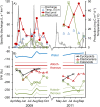Intraspecific Autochthonous and Allochthonous Resource Use by Zooplankton in a Humic Lake during the Transitions between Winter, Summer and Fall
- PMID: 25764501
- PMCID: PMC4357398
- DOI: 10.1371/journal.pone.0120575
Intraspecific Autochthonous and Allochthonous Resource Use by Zooplankton in a Humic Lake during the Transitions between Winter, Summer and Fall
Abstract
Seasonal patterns in assimilation of externally produced, allochthonous, organic matter into aquatic food webs are poorly understood, especially in brown-water lakes. We studied the allochthony (share biomass of terrestrial origin) in cladoceran, calanoid and cyclopoid micro-crustacean zooplankton from late winter to fall during two years in a small humic lake (Sweden). The use of allochthonous resources was important for sustaining a small population of calanoids in the water column during late winter. However, in summer the calanoids shifted to 100% herbivory, increasing their biomass several-fold by making efficient use of the pelagic primary production. In contrast, the cyclopoids and cladocerans remained at high levels of allochthony throughout the seasons, both groups showing the mean allochthony of 0.56 (range in mean 0.17-0.79 and 0.34-0.75, for the respective group, depending on model parameters). Our study shows that terrestrial organic matter can be an important resource for cyclopoids and cladocerans on an annual basis, forming a significant link between terrestrial organic matter and the higher trophic levels of the food web, but it can also be important for sustaining otherwise herbivorous calanoids during periods of low primary production in late winter.
Conflict of interest statement
Figures




References
-
- Ask J, Karlsson J, Jansson M. Net ecosystem production in clear-water and brown-water lakes. Global Biogeochemical Cycles. 2012;26:GB1017.
-
- Karlsson J, Berggren M, Ask J, Byström P, Jonsson A, Laudon H, et al. Terrestrial organic matter support of lake food webs: Evidence from lake metabolism and stable hydrogen isotopes of consumers. Limnology and Oceanography. 2012;57(4):1042–8.
-
- Algesten G, Sobek S, Bergström AK, Ågren A, Tranvik LJ, Jansson M. Role of lakes for organic carbon cycling in the boreal zone. Global Change Biology. 2004;10(1):141–7.
-
- Berggren M, Ziegler SE, St-Gelais NF, Beisner BE, del Giorgio PA. Contrasting patterns of allochthony among three major groups of crustacean zooplankton in boreal and temperate lakes. Ecology. 2014;95(7):1947–59. - PubMed
Publication types
MeSH terms
LinkOut - more resources
Full Text Sources
Other Literature Sources

